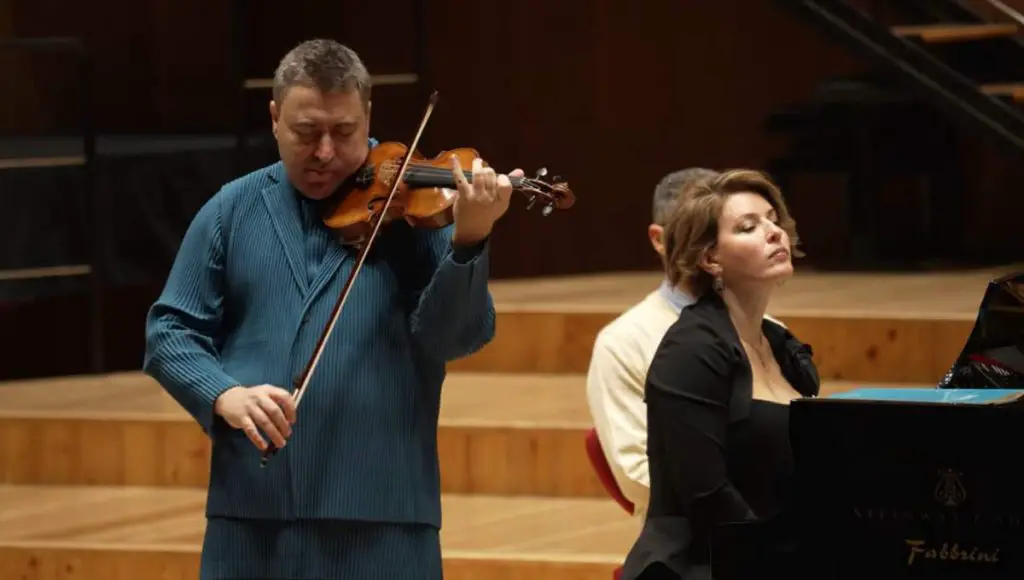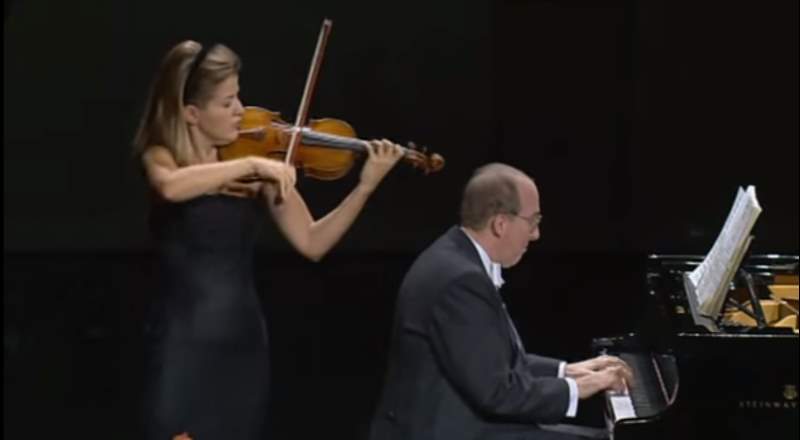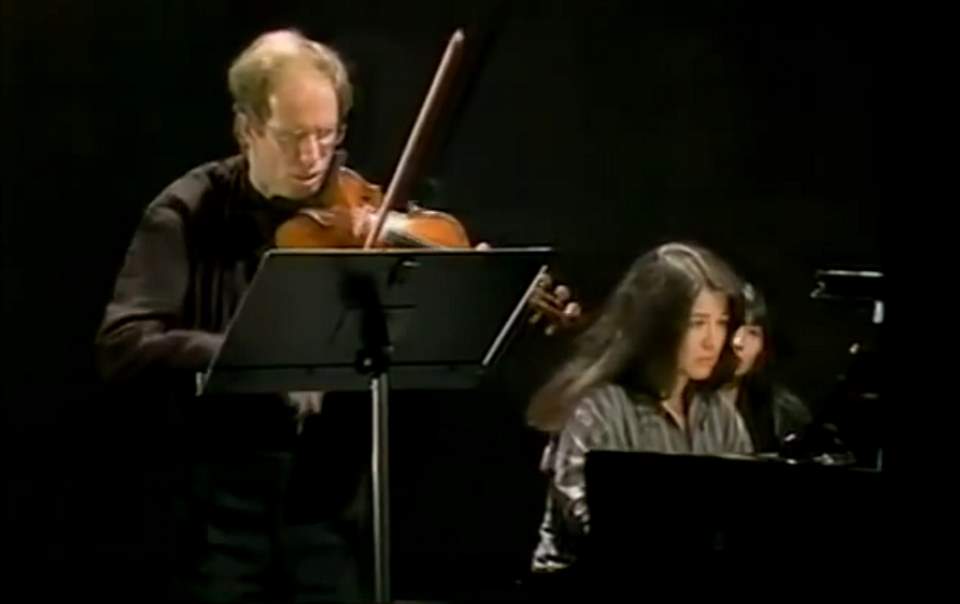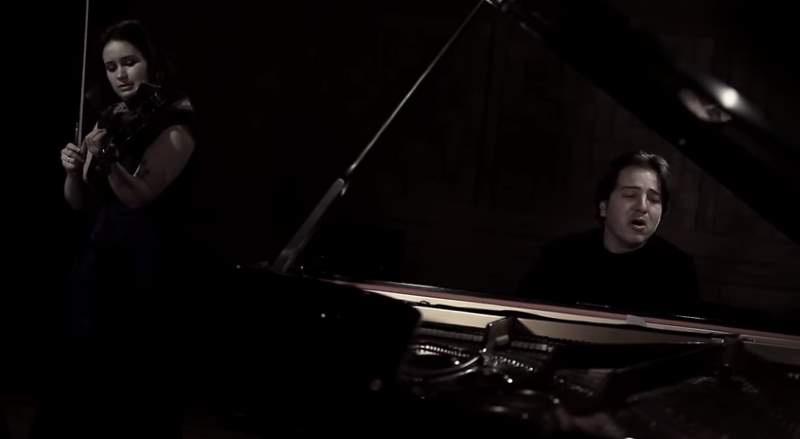Moldovan-Austrian violinist Patricia Kopatchinskaja and Turkish pianist Fazıl Say perform Ludwig van Beethoven’s Violin Sonata No. 9 Opus 47, commonly known as the “Kreutzer Sonata”.
Beethoven’s Violin Sonata No. 9, the “Kreutzer Sonata”
The “Kreutzer Sonata” was originally dedicated to the Afro-European (born in Poland) violinist George Bridgetower (11 October 1778 – 29 February 1860), who performed it with Beethoven at the premiere on 24 May 1803 at the Augarten Theatre at a concert that started at the unusually early hour of 8:00 am. Bridgetower sight-read the sonata; he had never seen the work before, and there had been no time for any rehearsal.
However, research indicates that after the performance, while the two were drinking, Bridgetower insulted the morals of a woman whom Beethoven cherished. Enraged, Beethoven removed the piece’s dedication, dedicating it to the French violinist Rodolphe Kreutzer (15 November 1766 – 6 January 1831), who was considered the finest violinist of the day.
However, Kreutzer never performed the piece, thinking it “outrageously unintelligible”. He did not particularly care for any of Beethoven’s music, and they only ever met once, briefly.
Sources suggest the work was originally titled “Sonata mulattica composta per il mulatto Brischdauer (Bridgetower), gran pazzo e compositore mulattico” (Mulatto Sonata composed for the mulatto Brischdauer, significant wild mulatto composer), and in the composer’s 1803 sketchbook, as a “Sonata per il Pianoforte ed uno violino obligato in uno stile molto concertante come d’un concerto”.
Referring to Beethoven’s composition, Leo Tolstoy’s novella The Kreutzer Sonata was first published in 1889. That novella was adapted into various stage and film productions, contributing to Beethoven’s composition becoming known to the general public.
Movements
The Kreutzer Sonata is in three movements:
- Adagio sostenuto – Presto (A major – A minor, sonata form)
- Andante con variazioni (F major, variation form, with the third variation in F minor)
- Presto (A major, sonata form)
1. Adagio sostenuto – Presto
The first movement of Beethoven’s Kreutzer Sonata, marked “Adagio sostenuto – Presto,” presents a gripping blend of emotional depth and technical brilliance, serving as an impactful introduction to the rest of the sonata. Unlike traditional sonata forms that often begin with a fast first movement, Beethoven chose to start this one with a slower, more introspective “Adagio sostenuto” section. This is somewhat of a preamble, setting the emotional tone for what is to come, almost like an operatic overture. Following this, the movement explodes into a “Presto,” characterized by dramatic, sometimes frenzied energy.
The technical demands on both the violin and piano are substantial. The piano and violin are equal partners, and their dialogues are replete with rapid runs, arpeggios, and trills. In the “Presto” section, the musical themes are developed through intricate sequences and variations that demonstrate Beethoven’s ingenuity in manipulating musical forms and structures. The themes introduced are both lyrical and rhythmic, providing a rich tapestry of sound that is explored and developed throughout the movement. Beethoven employs a wide dynamic range, adding to the drama and complexity.
Structurally, the first movement adheres to the sonata-allegro form but with Beethoven’s characteristic innovations. He manipulates the standard musical architecture by elongating certain sections and introducing unexpected harmonic progressions, making the familiar form feel fresh and novel. For instance, the development section doesn’t just dissect the themes presented in the exposition; it seems to transform them, creating a sense of continual discovery for the listener.
This movement embodies many elements that are quintessentially Beethoven: emotional depth, structural genius, and a sort of democratic interplay between the instruments, reflecting the societal ideals of equality and fraternity that were very much a part of the zeitgeist during Beethoven’s time.
Musicians often find themselves equally challenged and inspired by the emotional and technical demands of this movement. It requires not only virtuosity but also a deep understanding of the musical language Beethoven employed. It’s no surprise that this movement has been both a favorite and a milestone for many violinists and pianists, a piece that many aspire to perform but also find incredibly challenging.
2. Andante con variazioni
The second movement of Beethoven’s Kreutzer Sonata, marked “Andante con variazioni,” provides a significant contrast to the explosive energy of the first movement. This is a set of variations on a theme, a form that Beethoven excelled in and frequently used to explore the emotional and intellectual depths of relatively simple musical material.
The theme presented is lyrical and melodic, serving as a calm and collected basis upon which the variations are built. The recurring theme is almost song-like in its simplicity, providing a sense of grounding throughout the movement. Unlike the aggressive, fiery character of the first movement, the mood here is more introspective and tender, though it has its moments of tension and complexity.
In the subsequent variations, Beethoven subjects this theme to a variety of treatments that showcase both the violin and piano in different roles and configurations. Each variation exhibits unique rhythmic and harmonic ideas, adding complexity and depth to the movement. For example, some variations might focus on ornamental figures and embellishments, while others may introduce syncopated rhythms or surprising harmonic shifts.
Beethoven takes advantage of the technical capabilities of both instruments. At times, the piano carries the melodic line, while the violin provides color and textural complexity. At other moments, the roles are reversed, demonstrating Beethoven’s democratic approach to chamber music, where each instrument shares equally the expressive responsibilities of the piece.
This second movement acts as an emotional respite and provides balance within the overall architecture of the sonata. However, its more straightforward theme and variation structure should not be mistaken for simplicity or lack of depth. The harmonic richness and emotional nuance of this movement serve to deepen our understanding of Beethoven’s artistry and add to the overall impact of the sonata as a whole.
Though it’s not as frequently singled out for analysis as the more flamboyant first and third movements, the second movement remains an integral part of the Kreutzer Sonata’s emotional and structural design. It provides an essential contrast that enhances the dramatic effect of the surrounding movements.
3. Presto
The finale of Beethoven’s Kreutzer Sonata, marked “Presto,” serves as a powerful conclusion to the piece, combining both technical virtuosity and emotional intensity. It’s a rondo-like structure, characterized by the recurrence of a main theme that alternates with contrasting episodes. The movement bursts forth with an exhilarating tempo, almost as if the pent-up energy from the earlier movements is finally being unleashed.
Musically, the theme is robust and rhythmic, delivered in a relentless fashion that requires considerable technical prowess from both the violinist and the pianist. The recurring rondo theme acts as a sort of anchor, grounding the movement as it veers off into intricate episodes filled with rapid scales, arpeggios, and intense dialogues between the two instruments.
In the contrasting sections, Beethoven introduces elements of surprise through unexpected harmonic shifts and rhythmic complexities. There’s a sense of spontaneity and improvisation as if the music is being composed on the spot. This provides a thrilling experience for both the performers and the audience, keeping everyone on the edge of their seats.
Throughout the movement, Beethoven maintained a sense of equality between the violin and piano, a democratic approach that was groundbreaking for its time. Neither instrument is relegated to a purely accompaniment role; both share equally in presenting themes, creating contrasts, and contributing to the overall sense of tension and release that permeates the movement.
The finale captures the essence of Beethoven’s ingenuity in manipulating musical form and his ability to convey a broad range of emotions within a single work. The sheer intensity and technical demands of the third movement make it a tour-de-force for any performing duo. It not only tests the technical limits of the musicians but also challenges them to bring forth the emotional content embedded in the notes.
The third movement wraps up the sonata in a manner that reaffirms the groundbreaking nature of the entire work. It reflects Beethoven’s evolving compositional style, characterized by bold choices in form, tonality, and thematic development. In many ways, the third movement encapsulates the revolutionary spirit of the Kreutzer Sonata, serving as a fitting climax to one of the most iconic works in the chamber music repertoire.
Patricia Kopatchinskaja
Patricia Kopatchinskaja (born 1977 in Chișinău, Republic of Moldova, former Soviet Union) is a Moldovan-Austrian violinist.
In the view of the Jury of the Royal Philharmonic Society Music Award, “Patricia Kopatchinskaja is not only one of the most imaginative violinists around today, she is also a musician capable of galvanizing colleagues and mesmerizing audiences. Whether she is digging into the dark emotions of 20th-century masterpieces or championing new works she is as irresistible as a force of nature: passionate, challenging, and totally original in her approach.”
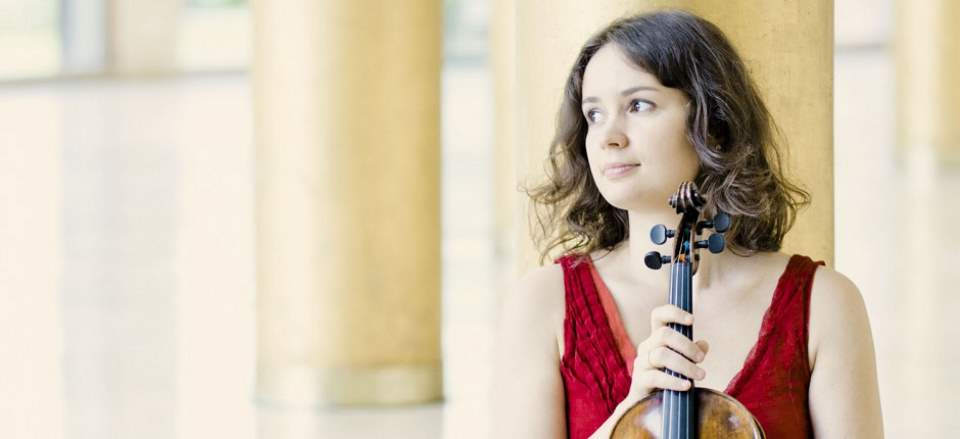
El Pais (Madrid) summarizes her contribution like this: “To a world of empty perfection and aseptic orthodoxy which classical music has become, Kopatchinskaja brings flavors of the past, of the nineteenth century where soloists were not robots, but creators”.
As soloist, she appeared with most of the leading orchestras of Europe, Russia, and Japan, including the Berlin Philharmonic, London Philharmonic Orchestra, Philharmonia Orchestra London, and Vienna Philharmonic as well as Vienna Symphony. Recently she extended her concert activity to the United States, Brazil, and China.
Kopatchinskaja worked with many of today’s leading conductors and there is a long-term collaboration with the following conductors: Vladimir Ashkenazy, Teodor Currentzis, Peter Eötvös, Heinz Holliger, Vladimir Jurowski, Sir Roger Norrington, Sakari Oramo and Andres Orozco-Estrada.
Fazıl Say
Fazıl Say (born January 14, 1970, in Ankara) is a Turkish pianist and composer.
He wrote his first piece, a piano sonata, as early as 1984, at the age of fourteen, when he was a student at the Conservatory of his hometown Ankara. It was followed, in this early phase of his development, by several chamber works without an opus number, including Schwarze Hymnen for violin and piano and a guitar concerto.
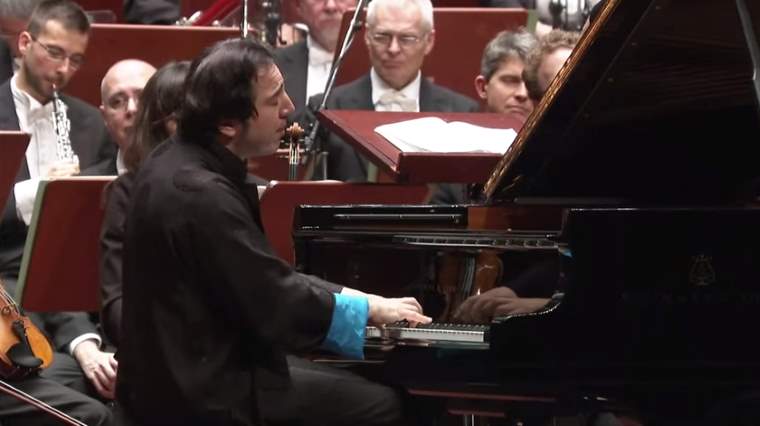
He subsequently designated as his opus 1 one of the works that he had played in the concert that won him the Young Concert Artists Auditions in New York: the Four Dances of Nasreddin Hodja. This work already displays, in essence, the significant features of his personal style: a rhapsodic, fantasia-like basic structure; a variable rhythm, often dance-like, though formed through syncopation; a continuous, vital driving pulse; and a wealth of melodic ideas that may often be traced back to themes from the folk music of Turkey and its neighbors.
In these respects, Fazıl Say stands to some extent in the tradition of composers like Béla Bartók, George Enescu, and György Ligeti, who also drew on the rich musical folklore of their countries. He attracted international attention with the piano piece Black Earth (1997), in which he employs techniques familiar to us from John Cage and his works for prepared piano.
Sources
- Violin Sonata No. 9 (Beethoven) on Wikipedia
- Patricia Kopatchinskaja on Wikipedia
- Fazıl Say on Wikipedia
